
Dime novel
Encyclopedia

Penny Dreadful
A penny dreadful was a type of British fiction publication in the 19th century that usually featured lurid serial stories appearing in parts over a number of weeks, each part costing an penny...
s or shilling shockers. American firms also issued foreign editions of many of their works, especially as series characters came into vogue. The term was being used as late as 1940, in the short-lived pulp Western Dime Novels. Dime novels are, at least in spirit, the antecedent of today’s mass market paperbacks, comic books, and even television
Television
Television is a telecommunication medium for transmitting and receiving moving images that can be monochrome or colored, with accompanying sound...
shows and movies based on the dime novel genres. In the modern age, "dime novel" has become a term to describe any quickly written, lurid potboiler
Potboiler
Potboiler or pot-boiler is a term used to describe a poor quality novel, play, opera, or film, or other creative work that was created quickly to make money to pay for the creator's daily expenses . Authors who create potboiler novels or screenplays are sometimes called hack writers...
and as such is generally used as a pejorative
Pejorative
Pejoratives , including name slurs, are words or grammatical forms that connote negativity and express contempt or distaste. A term can be regarded as pejorative in some social groups but not in others, e.g., hacker is a term used for computer criminals as well as quick and clever computer experts...
to describe a sensationalized yet superficial piece of written work.
Origin of term
It is generally agreed that the term originated with the first book in Beadle & Adam's Beadle’s Dime Novel series, Maleaska, the Indian Wife of the White Hunter, by Ann S. StephensAnn S. Stephens
Ann Sophia Stephens was an American novelist and magazine editor. She was the author of dime novels and is credited as the progenitor of that genre.- Early life :...
, dated June 9, 1860. The novel was essentially a reprint of Stephens's earlier serial that appeared in the Ladies' Companion magazine in February, March, and April 1839. The dime novels varied in size, even within this first Beadle series, but were roughly 6.5 by, with 100 pages. The first 28 were published without a cover illustration, in a salmon colored paper wrapper, but a woodblock print was added with issue 29, and reprints of the first 28 had an illustration added to the cover. Of course, the books were priced at ten cents.
This series ran for 321 issues, and established almost all the conventions of the genre, from the lurid and outlandish story to the melodramatic double titling that was used right up to the very end in the 1920s. Most of the stories were frontier tales reprinted from the vast backlog of serials in the story papers and other sources,Lax copyright enforcement allowed the publication of many foreign literary works without payment of royalties. as well as many originals.
As the popularity of dime novels increased, original stories came to be the norm. The books were themselves reprinted many times, sometimes with different covers, and the stories were often further reprinted in different series, and by different publishers.The proliferation of reprints has been the source of much confusion over the years, as regards “first prints.” As a general rule, the date of the printing can be determined from the list of other titles in the series found on the back cover. Dime novels were issued in twos or sometimes fours, so a true first printing will not list more than three numbers beyond the number on the cover. However, a later printing might list a hundred titles beyond the cover number. The books are so rare these days that the lateness of the printing does not bear much weight in pricing.
Beadle’s Dime Novels were immediately popular among young, working-class audiences, owing to an increased literacy rate around the time of the American Civil War
American Civil War
The American Civil War was a civil war fought in the United States of America. In response to the election of Abraham Lincoln as President of the United States, 11 southern slave states declared their secession from the United States and formed the Confederate States of America ; the other 25...
. By the war’s end, there were numerous competitors like George Munro and Robert DeWitt crowding the field, distinguishing their product only by title and the color choice of the paper wrappers. Even Beadle & Adams had their own alternate "brands", such as the Frank Starr line. As a whole, the quality of the fiction was derided by higher brow critics and the term 'dime novel' quickly came to represent any form of cheap, sensational fiction, rather than the specific format.
Prices
Adding to the general confusion as to what is or is not a dime novel, many of the series, though similar in design and subject matter, cost ten to fifteen cents. Even Beadle & Adams complicated the issue with a confusing array of titles in the same salmon colored covers at different price points. Also, there were a number of ten-cent, paper covered books of the period that featured medieval romance stories and soap opera-ish tales. This made it hard to define what falls within the definition of a true dime novel, with the division depending on format, price, or style of material for the classification. Examples of Dime Novel series that showcase the diversity of the term include: Bunce’s Ten Cent Novels, Brady’s Mercury Stories, Beadle’s Dime Novels, Irwin P. Beadle’s Ten Cent Stories, Munro’s Ten Cent Novels, Dawley’s Ten Penny Novels, Fireside Series, Chaney’s Union Novels, DeWitt’s Ten Cent Romances, Champion Novels, Frank Starr’s American Novels, Ten Cent Novelettes, Richmond’s Sensation Novels, Ten Cent Irish Novels, etc.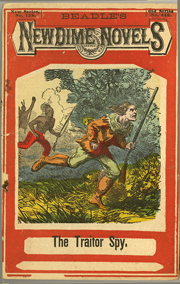
Development of the dime novel
As noted, much of the material for the dime novels came from the storypapers, which were weekly, eight page newspaper-like publications, varying in size from tabloid to a full fledged newspaper format, and usually costing five or six cents. They started in the mid 1850s and were immensely popular, some titles running for over fifty years on a weekly schedule. They are perhaps best described as the television of their day, containing a variety of serial stories and articles, with something aimed at each members of the family, and often illustrated profusely with woodcut illustrations. Popular storypapers included The Saturday Journal, Young Men of America, Golden Weekly, Golden Hours, Good News, Happy Days.There were English story papers as well, containing much the same sort of material. The stories were similarly reprinted in various other formats.Although the larger part of the stories stood alone, in the late 1880s series characters began to appear and quickly grew in popularity. The original Frank Reade
Frank Reade
Frank Reade was the protagonist of a series of dime novels published primarily for boys. The first novel, Frank Reade and His Steam Man of the Plains, an imitation of Edward Ellis's "The Steam Man of the Prairies" , was written by Harry Enton and serialized in the Frank Tousey juvenile magazine...
stories first appeared in Boys of New York. Old Sleuth, appearing in The Fireside Companion story paper beginning in 1872, was the first dime novel detective and began the trend away from the western and frontier stories that dominated the story papers and dime novels up to that time. He was the first character to use the word “sleuth” to denote a detective, the word’s original definition being that of a bloodhound trained to track. And he also is responsible for the popularity of the use of the word “old” in the names of competing dime novel detectives, such as Old Cap Collier, Old Broadbrim, Old King Brady, Old Lightning, Old Ferret and many, many others. Nick Carter
Nick Carter (literary character)
Nick Carter is a fictional character who began as a pulp fiction private detective and has appeared in a variety of formats over more than a century.-Literary history:...
first appeared in 1886 in The New York Weekly. All three characters would graduate to their own ten-cent weekly titles within a few years.Nick Carter has proved to be one of the most durable, if bland, fictional characters of all time. In one incarnation or another, he has been active for over 100 years, most recently as Nick Carter, Killmaster in a long running paperback series.
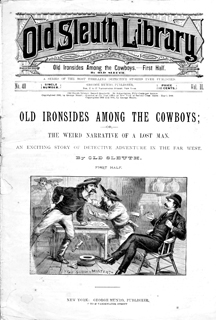
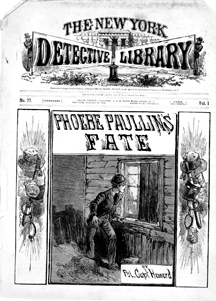
Changing formats
In 1873, the house of Beadle & Adams had introduced a new ten-cent format, 9 by 13.25 in (228.6 by 336.6 mm), with only 32 pages and a black and white illustrated cover, with the title New and Old Friends. It was not a success, but the format was so much cheaper to produce that they tried again in 1877 with The Fireside Library and Frank Starr’s New York Library. The first reprinted English love stories, the second contained hardier material but both titles caught on. Publishers were no less eager to follow a new trend then than now. Soon the newsstands were flooded by ten-cent weekly “libraries”. These publications also varied in size, from as small as 7 x 10 inches (The Boy’s Star Library is an example) to 8.5 x 12 (New York Detective Library). The Old Cap Collier Library was issued in both sizes, plus a booklet form. Each issue tended to feature a single story, as opposed to the story papers, and many of them were devoted to single characters. Frontier stories, evolving into westerns, were still popular, but the new vogue tended to urban crime stories. One of the most successful titles, Frank Tousey’s New York Detective Library eventually came to alternate stories of the James Gang with stories of Old King Brady, detective, and in a rare occurrence in the dime novel world, there were several stories which featured them both, with Old King Brady doggedly on the trail of the vicious gang.Nick Carter also made appearances in stories featuring other detectives, such as Old Broadbrim, much as superheroes crossover in today’s comic books.The competition was fierce, and publishers were always looking for an edge. Once again, color came into the fray when Frank Tousey introduced a weekly with brightly color covers in 1896. Street & Smith countered by issuing a smaller format weekly with muted colors Such titles as New Nick Carter Weekly (continuing the original black and white Nick Carter Library), Tip-Top Weekly (introducing Frank Merriwell
Frank Merriwell
Frank Merriwell is a fictional character appearing in a series of novels and short stories by Gilbert Patten, who wrote under the pseudonym Burt L. Standish...
) and others were 7 x 10 with thirty-two pages of story, but the 8.5 x 11 Tousey format carried the day and Street & Smith, soon followed suit. The price was also dropped to five cents, making the magazines more accessible to children. This would be the last major permutation of the product before it evolved into pulp magazines. Ironically, for many years it has been the nickel weeklies that most people refer to when using the term "dime novel."
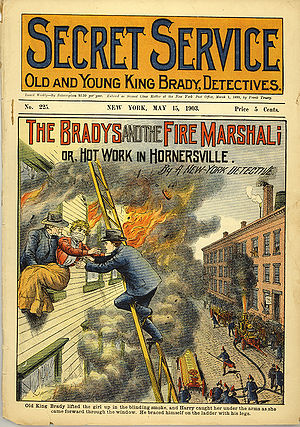
Perhaps the most confusing of all the various formats that are lumped together under the term dime novel are the so-called “thick-book” series, largely published by Street & Smith, J. S. Ogilvie and Arthur Westbrook. These books were published in series, ran roughly 150-200 pages, and were 4.75 by 7 in (120.7 by 177.8 mm), often with color covers on a higher grade stock. They reprinted multiple stories from the five- and ten-cent weeklies, often slightly rewritten to tie the material together.
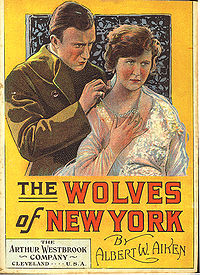
End of the dime novel
In 1896, Frank Munsey had converted his juvenile magazine, The Argosy into a fiction magazine for adults and the first pulp. By the turn of the century, new high-speed printing techniques combined with the cheaper pulp paper allowed him to drop the price from twenty five cents to ten cents, and the magazine really took off. In 1910 Street and Smith converted two of their nickel weeklies, New Tip Top Weekly and Top Notch Magazine, into pulps; in 1915, Nick Carter Stories, itself a replacement for the New Nick Carter Weekly, morphed into Detective Story Magazine, and in 1919, New Buffalo Bill Weekly became Western Story Magazine. Harry Wolff, the successor in interest to the Frank Tousey titles, continued to reprint many of them up into the mid 1920s, most notably Secret Service, Pluck and Luck, Fame and Fortune, and Wild West Weekly. The latter two were purchased by Street & Smith in 1926 and converted into pulp magazines the following year. That effectively ended the reign of the dime novel.Collections
In the late 1940s to the early 1950s, collecting dime novels became very popular, and prices soared. Albert Johannsen authored an enormous two volume scholarly work, The House of Beadle & Adams, which is exhaustive in its detail. Even at that time the cheap publications were crumbling into dust and becoming hard to find. William J. BennersWilliam J. Benners
William James Benners, Jr. was a writer, publisher, and historian of dime novels, a class of popular fiction that flourished in the mid- and late-nineteenth century and into the early twentieth century...
was another of the early historians of the dime novel. He was also a publisher and author. Edward T. LeBlanc, a longtime editor of the periodical Dime Novel Round-Up, was also an avid collector and bibliographer of the format. Two of the prominent collectors, Charles Bragin and Ralph Cummings, issued a number of reprints of particularly hard to find titles from some of the weekly libraries.These reprints turn up quite frequently today, and are often confused with originals, as the notice of their reprint status is not very prominent.
But most of the collectors were men who remembered the stories from childhood, and as they passed on, the craze subsided and dime novels, of all varieties, lost their appeal and are only marginally collected today.
- Library of CongressLibrary of CongressThe Library of Congress is the research library of the United States Congress, de facto national library of the United States, and the oldest federal cultural institution in the United States. Located in three buildings in Washington, D.C., it is the largest library in the world by shelf space and...
through copyright deposit has accumulated a collection of nearly 40,000 titles. - Stanford UniversityStanford UniversityThe Leland Stanford Junior University, commonly referred to as Stanford University or Stanford, is a private research university on an campus located near Palo Alto, California. It is situated in the northwestern Santa Clara Valley on the San Francisco Peninsula, approximately northwest of San...
has a collection of over 8,000 individual dime novels, and a web site devoted to the subject. - The University of South Florida-Tampa Special Collections Department has an extensive collection of nearly 9,000 dime novels, including Frank Tousey's the Frank Reade Library and the Frank Reade Weekly Magazine.
- Rare Books and Special Collections at Northern Illinois University holds over 50,000 dime novels in its Johannsen and LeBlanc Collections. While much of NIU's collection is not fully cataloged, the novels are accessible to users.
- The Edward G. Levy Dime Novel Collection is housed at the Fales LibraryFales LibraryNew York University's Fales Library and Special Collections is located on the third floor of the Elmer Holmes Bobst Library at 70 Washington Square South between LaGuardia Place and the Schwartz Plaza, in the Greenwich Village neighborhood of Manhattan, New York City. It houses nearly 200,000...
at New York University. A complete Finding Aid to the collection is now available online. - NYU's Fales LibraryFales LibraryNew York University's Fales Library and Special Collections is located on the third floor of the Elmer Holmes Bobst Library at 70 Washington Square South between LaGuardia Place and the Schwartz Plaza, in the Greenwich Village neighborhood of Manhattan, New York City. It houses nearly 200,000...
also houses the Ralph Adimari Papers and the William J. BennersWilliam J. BennersWilliam James Benners, Jr. was a writer, publisher, and historian of dime novels, a class of popular fiction that flourished in the mid- and late-nineteenth century and into the early twentieth century...
Papers. Adimari was a historian who studied dime novels. His papers include research notes, clippings, and ephemera related to dime novels. William J. Benners was a writer and publisher of dime novels. Link to the Fales Library guide to the Ralph Adimari Papers Link to the Fales Library guide to the William J. Benners Papers - The University of Missouri - Columbia houses a small collection of dime novels in its Division of Special Collections, Archives and Rare Books
See also
- Penny DreadfulPenny DreadfulA penny dreadful was a type of British fiction publication in the 19th century that usually featured lurid serial stories appearing in parts over a number of weeks, each part costing an penny...
- Story PaperStory paper*This article is about British Story papers. For the U.S. version, see Dime novel.A story paper is a periodical publication similar to a literary magazine, but featuring illustrations and text stories, and aimed towards children and teenagers...
- Pulp MagazinePulp magazinePulp magazines , also collectively known as pulp fiction, refers to inexpensive fiction magazines published from 1896 through the 1950s. The typical pulp magazine was seven inches wide by ten inches high, half an inch thick, and 128 pages long...
- MelodramaMelodramaThe term melodrama refers to a dramatic work that exaggerates plot and characters in order to appeal to the emotions. It may also refer to the genre which includes such works, or to language, behavior, or events which resemble them...
- Horror FictionHorror fictionHorror fiction also Horror fantasy is a philosophy of literature, which is intended to, or has the capacity to frighten its readers, inducing feelings of horror and terror. It creates an eerie atmosphere. Horror can be either supernatural or non-supernatural...
- Gothic Novel
- Frank ReadeFrank ReadeFrank Reade was the protagonist of a series of dime novels published primarily for boys. The first novel, Frank Reade and His Steam Man of the Plains, an imitation of Edward Ellis's "The Steam Man of the Prairies" , was written by Harry Enton and serialized in the Frank Tousey juvenile magazine...
- Eugene T. SawyerEugene T. SawyerEugene Taylor Sawyer was a newspaper editor and author of dime novels, particularly for the Nick Carter series. In an interview given in 1902, he confessed to having written over 75 examples of that genre, most anonymously...
External links
- Link to the Fales Library guide to the William J. Benners Papers-writer and publisher of dime novels
- Link to the Fales Library guide to the Ralph Adimari Papers-historian who studied dime novels
- Guide to the Levy Dime Novel Collection at Fales Library of NYU
- Harper's Weekly Cartoon, March 11, 1882, "Our Youth and Youth's Literature from a Chinese Point of View"
- Dime Novels and the Penny Dreadfuls are housed in the Department of Special Collections and University Archives at Stanford University Libraries
- The University of South Florida Tampa Library has nearly 9,000 dime novels, of which roughly 10% are catalogued
- Dime Novel Round-Up "A magazine devoted to the collection, preservation and study of old-time dime and nickel novels, popular story papers, series books, and pulp magazines."
- Sweeney Todd and penny dreadfuls
- Library of Congress dime novel collection
- The Albert Johannsen Collection of Dime Novels at Northern Illinois University
- The Edward T. LeBlanc Collection of Dime Novels at Northern Illinois University
- "The Mysteries of London", an 1840s penny dreadful.
- "Fred Fearnot" Dime Novels

